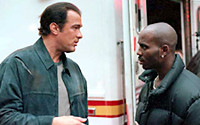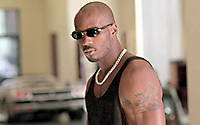

Exit Wounds
by Michelle Holliday
![]()
__________________________________________
In the "movie business", many filmmakers are entertaining the
intellect as well as the imagination. Films tend to carry a deeper meaning
than expected. The audience is led up to an intriguing climax with a twisted
plot. What does this mean? The viewer has the freedom to preconceive how
the movie will end; the catch is, the director has the ability to play
with elements to lead viewers in a certain direction. These directions
can twist and turn depending on how the elements are being used. In Exit
Wounds the director has chosen to play with the music, characters,
and costumes. Configuring these elements in specific ways intrigues the
audience while communicating a theme.
The movie occurs in Chicago at the fifteenth district (a police station.) Steven Seagal plays Orin Boyd, a police officer who will stop at nothing to put an end to street crime. The villain is played by DMX (a popular rap artist). As the movie begins the audience is entertained with exquisitely choreographed fight scenes and outstanding graphics. The classic "cat-and-mouse chase" begins with Steven Seagal hunting down DMX. The movie looks like your typical "cop" movie but then takes an intriguing turn. The director begins to give clues leading to a surprising climax and resolution.
The music used throughout the movie is by DMX. Each song is strategically placed depending on lyrics and meaning. The lyrics in each piece give clues to the theme and plot. Songs conveying, "fight for what is right" are played every time DMX is forced to fight his way out of the hands of justice. This seems a little odd since DMX is the villain promoting street crime. As certain officers are introduced, songs of "injustice" and "corruption" are played. Most viewers only subconsciously pick up on the meaning of these songs. The director has intentionally made the instrumentals louder then the lyrics. Lyrics, almost drowned out by the beat, are in the background of the song. This effect gives the movie an upbeat urban feel while dropping the audience subtle clues to the plot.
The use of famous people was essential for character development. Steven Seagal has played in many movies. He is known for his intelligence and outstanding ability to fight. Seagal is six feet five inches and fifty years old. Now the viewer assumes that because of his age, Seagal carries wisdom and experience in law enforcement. Seagal's size speaks for itself. "He is a force to be reckoned with." DMX, a popular rap artist, natural lends himself to the villain role. He grew up in the "hood" in real life. This experience obviously gives him an advantage while playing the role and making it believable. The director played on stereotypical views by casting these two actors. Selecting Seagal and DMX adds to the realism and theme of the movie.
Costumes help to add conflict. Most officers are dressed in pressed trim uniforms. However, Steven Seagal is viewed in street cloths throughout most of the movie. This costuming lets the audience know that he is acting without the commander's consent. When the other officers are viewed in street clothing this costuming gives the audience clues that the behaviors are not permitted. DMX is always dressed in "club cloths", which are general quite expensive and flashy. The director uses the choice of costumes to enhance the stereotypical views the audience may have.
The director
is able to play on stereotypes to lead the audience through his movie
reveling an unexpected climax, theme, and plot. Music, characters, and
costumes were cleverly chosen to enhance the movies realism. I'll let
you in on the theme: "never judge a book by its cover". The
plot and twist you'll have to see for yourself.